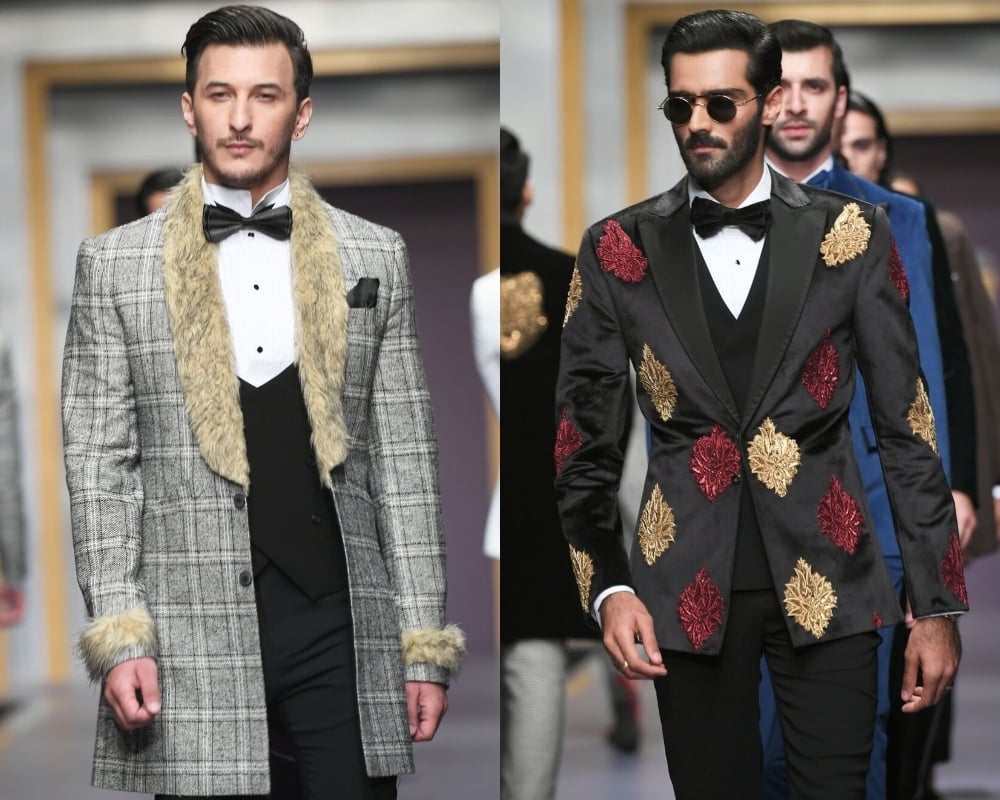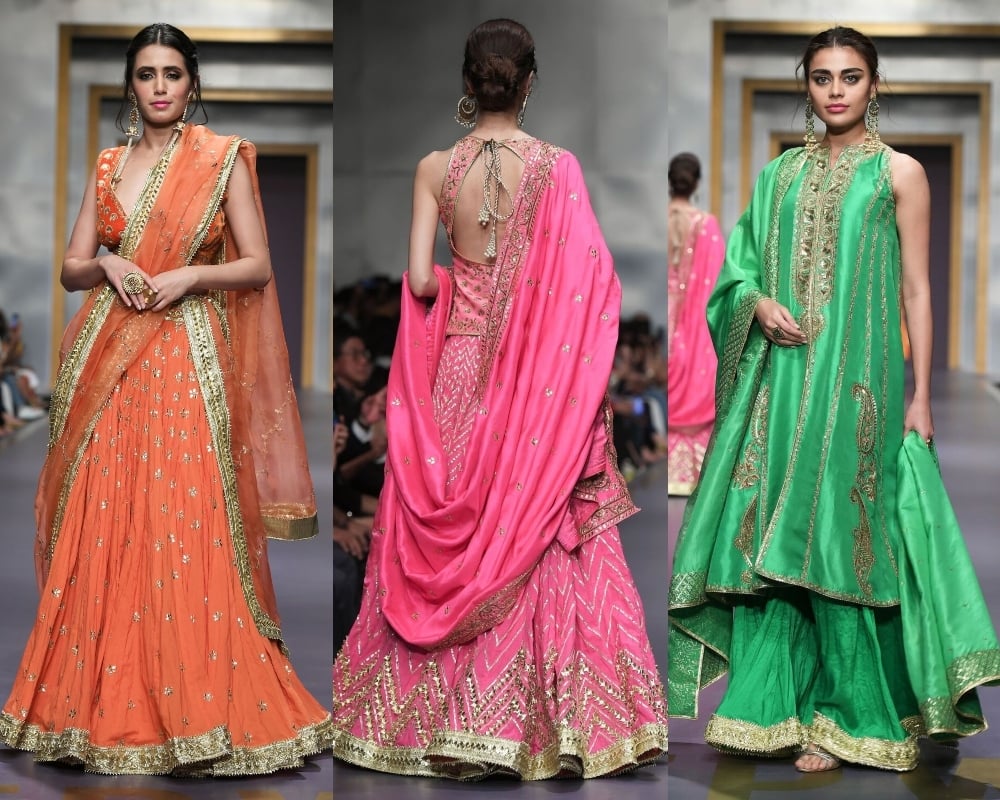Milan comes to Pakistan and sets the second day of FPW to a great start
Start fashion week off with an exciting designer. End it with a big veteran name. Throw in some heavy duty celebrity tamasha with preferably some jumping about on the catwalk. Whisk them all together and you’ve got a day at fashion week where the energy runs high, cameras keep clicking and the audience keeps cheering.
Case in point: the second day of the Winter Festive edition of Fashion Pakistan Week (FPW).
Read: On FPW Day 1, Al-Karam opens the show well...and then it all goes downhill
The first collection of the day was by visiting Italian designer Stella Jean, hot off the Milan Fashion Week runway, merging embroideries from the Kalash Valley and local print motifs with a number of impeccably finished garments.
The last collection of the day was by Maheen Khan, who turned her expert eye towards the creation of fanciful, luxe silhouettes.
Strewn between the opening act and the finale were collections that were great and not-so-great and a veritable flood of celebrities. Entertainment, if not always bona fide fashion, remained at a high.
Stella Jean
In March this year, Stella Jean, a designer from Italy, visited Pakistan at the behest of the Pakistani Ministry of Commerce. She visited textile factories and saw various indigenous craft techniques but became fixated with the handwork that is unique to the Kalash valley.

With her penchant for ethical fashion, Stella had previously worked with artisans from other countries, intermingling their craft with her design sensibility. Now, she decided that she wanted to work with the craftswomen of the Kalash.
The fruition of this collaboration was showcased a little more than a month ago at Milan Fashion Week — and now, at FPW.
Read: Mushk Kaleem and Alicia Khan are just about to walk the ramp at Milan Fashion Week
In her endeavor to help build an Italy-Pakistan bridge, Stella had commissioned work to the women. They embroidered fabric according to her instructions and then their finished work was sent to her in Italy, where the final garments were stitched.
Much effort had to be made to maintain quality. An embroidered swathe with stains on it would be rejected and remade all over again. The logistics of transporting the fabric and embroideries back and forth also took time.
It was a tedious project — but a worthwhile one both from a social perspective as well as commercial. In Milan, Stella’s collection gained a lot of attention from the press and managed to depict Pakistan in a different light. Designs placed online sold out immediately.
At FPW, Stella’s multicoloured canvas served as an apt homage to the beauty and skill that is inherent to Pakistan. The Kalash embroideries stood out as did the truck-art prints created with the assistance of the National College of Arts.
The flowing white dress with its swathes of layers and blue embroidered border, worn by model Mushk Kaleem, was a timeless statement. The multi-tiered fringed skirt was another favourite.

Accessories amped up looks: parandas winding through hair and quirky footwear and the finishing was impeccable. Dresses cut so neatly are rare on the local runway.
On a side note, Stella’s opening act hauled in quite an illustrious guest list. Sitting in the front-rows, were diplomats from the US, UK, Italy, Germany and Thailand, accompanied by Zahir Rahimtoola. The presence of official foreign representatives may not lead to instant results, but it hints at the hope of similar Pakistani and international collaborations in the future.

I am sure they liked Stella’s show. But I wonder what their thoughts were on the dhol dhamaka that followed immediately afterwards…
Humayun Alamgir
If energy was at a high in the opening show, it shot right up to the skies when Humayun Alamgir took over the catwalk.
Droves of celebrities came out, dancing, springs in their feet as they veritably jumped down the runway. Shahzad Sheikh opened the show, followed by Fahad Mirza, Ali Safina, Agha Ali, Muneeb Butt and Asad Siddiqui. The collection was called ‘Style Mara Tou Darna Kya’ and these boys were certainly completely unafraid!

Humayun Alamgir dresses stars often — scan any recent red carpet ceremony and you’ll see many of our male celebrities wearing his suits. And famous friends certainly come in handy when you’ve got to put on a star-studded show.
Fast-paced and fun, this was the sort of show that had the audience cheering. The videos of all the catwalk antics promptly went viral.
This was, however, fashion week and not an awards ceremony. As much as we love celebrities, what were the clothes like?

The simpler, more sedate suiting had potential: a turtleneck paired with a white blazer and double-breasted suits in dark monotones.

The more flamboyant jackets and suits — in shiny blues, greens and maroons and one, with a fur border – simply did not have the sophistication that is the hallmark of a well-tailored man’s suit.
Pink Tree Company
The Pink Tree Company’s Colour by Technicolour flowed out on to the catwalk like a shiny rainbow, twinkling with gota and zardozi and molded to the traditional silhouettes that are now the brand’s signature: lehngas, ghararas and baggy, free-flowing kurtas.

The gota ran in pretty patterns but what truly stood out were the colors and the uncluttered palette. There was no unnecessary layering or sudden splurges into complicated, unfathomable silhouettes.

The single-tone outfits could be appreciated for their simplicity and the beauty of age-old embroideries etched onto them.

Having said this, some of the clothes would have benefitted from better tailoring, especially the sleeveless cholis and backless shirts.
Zuria Dor
Zuria Dor’s collection was a tad confusing. The brand started out with basic Western-wear, pairing whites with brighter hues. It was all quite wearable but didn’t offer anything new.

Also, these very basic silhouettes were not particularly the sort of clothes a designer brand puts out on the catwalk. Something more: a change in silhouette, colour, print, even styling would have made these clothes more memorable.
And then, in a strange about-turn, lehngas and ghararas started trooping out on the catwalk. Some of the wedding-wear was pretty, dabbling into unconventional hues and embroideries.

But how can cotton-based Western pret be crammed with bridal couture in a single show? How could the brand not foresee this very glaring error? Why did the Fashion Pakistan Council not edit this collection and steer it in more coherent directions?
Zellbury
The weakest point in Zellbury’s show was when showstopper Hina Altaf came on the catwalk, dressed in a large, billowing kaftan dress.
She began walking down the ramp but I am assuming that she found the clothes difficult to manage, which is why she launched into a strange jiggle. She continued this dance as she walked back, occasionally tripping over the kaftan’s folds. She kept smiling too. What a sport.
Unless, maybe, she was just dancing because she felt like it?
Moving on from this conjecture, Zellbury’s collection featured plenty of variations in print: polka dots, geometrics and tie-dye but on silhouettes that were badly constructed and unflattering.

As a high-street brand, it would have made better sense to showcase wearable but interesting clothing that could actually be available at Zellbury stories. But very few high-street brands understand this basic fact. Place them on a catwalk and they veer towards odd variations of couture.
Splash
Splash, however, understood what a high-street fashion show needs to be like. The show featured clothes for both men and women which, I hope, will be available at the brand’s stores soon.

Jeans, knee-high jumpsuits, dresses, tank tops and tees came layered with basic jackets, giving a nod to FPW’s ‘winter’ theme — a nod that not many brands are acknowledging, opting to put out whatever works for them without worrying too much about the season.

The styling was great too. The girls’ hair was braided with multicoloured bands, there were quirky sunglasses and model Walid Siddiqui even came out twirling a basketball. Very cool.
Maheen
Maheen Khan’s show was a strong one, but one where I felt colour and fabric were far more noticeable than silhouette. The designer molded pure silk in the most beautiful hues to create relaxed, over-sized apparel.

A neckline carelessly ran lopsided, wide belts cinched large dresses at the waist, there were bows, ruffles and billowing sleeves.

My favourite was the very first outfit, worn by Areeba Habib: a slinky, hybridised version of the sari.

It was an assured end to the second day of fashion week. If nothing else, Maheen Khan has always been very assured about the designs she likes, wears and sells!





Comments